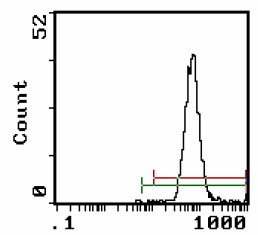C3ar1 Mouse Monoclonal Antibody [Clone ID: 74]
Other products for "C3ar1"
Specifications
| Product Data | |
| Clone Name | 74 |
| Applications | FC, IHC |
| Recommended Dilution | Flow Cytometry. Immunohistochemistry on frozen sections. |
| Reactivities | Rat |
| Host | Mouse |
| Isotype | IgG1 |
| Clonality | Monoclonal |
| Immunogen | RBL-2H3 transfectants expressing rat C3aR Donor: BALB/c Fusion Partner: X63-Ag8.653 |
| Specificity | This rat C3a receptor antibody detects a recombinant peptide corresponding to amino acids 161-321 of the large extracellular loop structure, which shares 34% homology with mouse and human. Deduced amino acid sequences of human/rat C3aR is 58.5% and 90.7% with rat/mouse. |
| Formulation | PBS containing 0.02% sodium azide (NaN3) as preservative and EIA grade BSA was added as a stabilizing protein to bring the total protein concentration to 4-5 mg/ml. Label: FITC State: Liquid purified Ig fraction Label: Fluorescein isothiocyanate isomer 1 |
| Concentration | 0,1 mg/ml |
| Purification | Affinity chromatography on Protein G |
| Conjugation | FITC |
| Gene Name | Rattus norvegicus complement C3a receptor 1 (C3ar1) |
| Database Link | |
| Background | C3aR binds to anaphylotoxin C3a which, among other things, is involved in mast cell degranulation and recruitment of immune cells to the site of inflammation. Activation of the complement cascade produces various fragments, including C3a and C5a. C3aR is characterized by seven transmembrane domains including a large extracellular loop which is coupled to a Gi protein. C3aR expression is detected on glial cells, neurons and cells belonging to the mononuclear phagocyte system. C3aR expression was shown to moderately increase after LPS stimulation. |
| Synonyms | C3a-R, C3AR, C3AR1, AZ3B, C3R1, HNFAG09 |
| Note | Protocol: FLOW CYTOMETRY ANALYSIS: Method: 1. Prepare a cell suspension in media A. For cell preparations, deplete the red blood cell population with Lympholyte®-Rat cell separation medium. 2. Wash 2 times. 3. Resuspend the cells to a concentration 2x10e7 cells/ml in media A. Add 50 μl of this suspension to each tube (each tube will then contain 1x10e6 cells, representing 1 test). 4. To each tube, add 0.5μg of this antibody. 5. Vortex the tubes to ensure thorough mixing of antibody and cells. 6. Incubate the tubes for 30 minutes at 4°C. 7. Wash 2 times at 4°C. 8. Add 100 μl of secondary antibody (FITC Goat anti-mouse IgG) at 1/500 dilution. 9. Incubate the tubes at 4°C for 30-60 minutes. (It is recommended that the tubes are protected from light since most fluorochromes are light sensitive). 10. Wash 2 times at 4°C in media B. 11. Resuspend the cell pellet in 50 μl ice cold media B. 12. Transfer to suitable tubes for flow cytometric analysis containing 15 μl of propidium iodide at 0.5 mg/ml in PBS. This stains dead cells by intercalating in DNA. Media: A. Phosphate buffered saline (pH 7.2) + 5% normal serum of host species + sodium azide (100 μl of 2M sodium azide in 100 mls). B. Phosphate buffered saline (pH 7.2) + 0.5% Bovine serum albumin + sodium azide (100 μl of 2M sodium azide in 100 mls). Results: Tissue Distribution by Flow Cytometry Analysis: Rat Strain: Wistar Cell Concentration: 1x10e6 cells per test Antibody Concentration Used: 2.0μg /106 cells Isotypic Control: FITC Mouse IgG1 Cell Source: Peritoneal Macrophages 97.2% Bone Marrow 81.5% |
| Reference Data | |
Documents
| Product Manuals |
| FAQs |
| SDS |
{0} Product Review(s)
0 Product Review(s)
Submit review
Be the first one to submit a review
Product Citations
*Delivery time may vary from web posted schedule. Occasional delays may occur due to unforeseen
complexities in the preparation of your product. International customers may expect an additional 1-2 weeks
in shipping.






























































































































































































































































 Germany
Germany
 Japan
Japan
 United Kingdom
United Kingdom
 China
China



